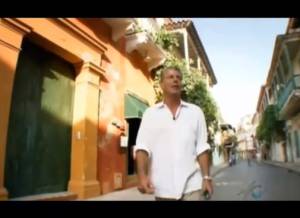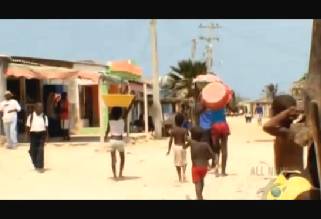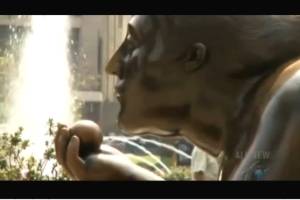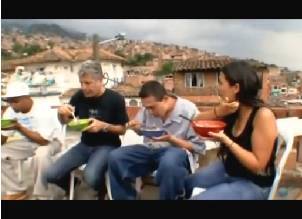Colombia is a bright and beautiful country that has gone from drug capital to food capital. Anthony Bourdain admits he's fascinated with Colombia's tragic past, so he's exploring Colombia to discover its unique cuisine and unknown magic.
Introduction:
Colombia
Colombia, officially the Republic of Colombia, is the twenty-sixth largest country by total area, and the twenty-seventh largest by population, and the second largest in South America, after Brazil. Colombia has the third largest population of any Spanish-speaking country in the world, after Mexico and Spain. Colombia is the only South American country with coasts on the Pacific Ocean and Caribbean Sea, where it has several islands and the archipelago of San Andres and Providencia.
Colombia is one of the world's most ethnically diverse and multicultural nations. Colombia is very ethnically diverse, and the interaction between descendants of the original native inhabitants, Spanish colonists, Africans brought as slaves and 20th century immigrants from Europe and the Middle East has produced a rich cultural heritage. This has also been influenced by Colombia's varied geography. The majority of the urban centres are located in the highlands of the Andes mountains, but Colombian territory also encompasses Amazon rainforest, tropical grassland and both Caribbean and Pacific coastlines.
Ecologically, Colombia is one of the world's 17 megadiverse countries, and is considered the most megadiverse per square kilometer. Colombia Is recognized worldwide for the production of palm oil, mild coffee, flowers, emeralds, coal, and oil. Between 1980 and 1996, Colombia was considered the largest producer of cocaine in the world, but thanks to the reform efforts of recent times, the estate tax and Plan Colombia led by the United States, the landscape has changed significantly.
Colombia is a unitary constitutional republic comprising thirty-two departments. The Colombian economy is the fourth South American largest national economy, with an estimated 2010 GDP of $435.367 Billion. Colombia is a standing middle power with the fourth largest economy in Latin America. However income and wealth are unevenly distributed. In 1990, the income ratio between the richest and poorest 10% was 40-to-1, climbing to 80-to-1 in 2000. In 2009, 46% of Colombians lived below the poverty line and 17% in "extreme poverty".
Cartagena
Cartagena is a large Caribbean beach resort city on the northern coast of Colombia. The city had a population of 892,545 as of the 2005 census making it the fifth-largest city in Colombia. Cartagena is a centre of economic activity in the Caribbean, as well a popular tourist destination. In 1984, Cartagena's colonial walled city and fortress were designated a UNESCO World Heritage Site.
Cartagena was founded on 1 June 1533 by Spanish commander Pedro de Heredia. The town was named after Cartagena, Spain, where most of Heredia's sailors came from. The dramatically increasing fame and wealth of the prosperous city turned it into an attractive plunder site for pirates and privateers licensed by their French or English king.
The city then set about strengthening its defences and surrounding itself with walled compounds and castles. Engineering works took well over 208 years and ended with some eleven kilometres of walls surrounding the city, including the Castillo San Felipe de Barajas, named in honor of Spain's King Philip IV. It was constructed to repel land attacks, equipped with sentry boxes, buildings for food and weapons storage, and underground tunnels. When the defenses were finished in 1756, the city was considered impregnable.
Cartagena was a major trading port, especially for precious metals. Gold and silver from the mines in the New Granada and Peru were loaded in Cartagena on the galleons bound for Spain via Havana.
Cartagena was also a slave port; Cartagena and Veracruz, (Mexico), were the only cities authorized to trade African slaves. The first slaves arrived with Pedro de Heredia and worked as cane cutters to open roads, in the raiding and desecration of tombs of the aboriginal population of Sinú for its gold and artifacts, and in the construction of buildings and fortresses. The agents of the Portuguese company Cacheu distributed human "cargoes" from Cartagena for mine exploitation in Venezuela, the West Indies, the Nuevo Reino de Granada and the Viceroyalty of Perú.
The "Silver Age" of the city (1750–1808) was a period of permanent expansion of the existing buildings, massive immigration from all the other cities of the Viceroyalty, increase of the economic and political power of the city and a population growth spurt not equaled since that time. The Viceroys decided to reside in Cartegena permanently. The inhabitants of the city were the richest of the colony, the aristocracy erected noble houses on their lands to form great estates, libraries and printing establishments were opened.
The good times of steady progress and advancement in the second half of the 18th century came to an abrupt end in 1808 with the general crisis of the Spanish Empire that came from the Mutiny of Aranjuez and all its consequences. For more than 275 years, Cartagena was under Spanish rule. On November 11, 1811, Cartagena declared its independence.
Medellín
Medellín is the second largest city in Colombia, with more than 3.5 million people. The ethnographic makeup of the city is: 70% White (descendants of Spanish colonists, including Basques, Sephardic Jews, Ashkenazi Jews, other Europeans, and Arabs), 20% Mestizo (those of mixed Spanish and indigenous Amerindian descent), 6.5% Afro-Colombian, and 0.1% Indigenous Amerindians.
During the 19th century, Medellín was a dynamic commercial center, first exporting gold, then producing and exporting coffee. During the 1930s, the textile industry was developed by families whose fortunes came from colonial-era gold mines. Glass, beverage, and food industries also were founded during the 1930s, and contributed to making Medellín the top industrial region of Colombia. The position of Medellín as the top industrial city in Colombia has been a main factor in overcoming its crisis of the 1980s and 1990s.
Medellín was once known as the most violent city in the world, a result of an urban war set off by the drug cartels at the end of the 1980s. As the home of the Medellín Cartel funded by Pablo Escobar, the city was victim of the terror caused by the war between the organization headed by Escobar, and competing organizations such as "El Cartel del Valle". However, after the death of Escobar, crime rates in the city began to decrease. Throughout the rest of the 1990s crime rates remained relatively high, although gradually declining from the worst years. An average of 9 people were killed every day in 2009.
Today, the main economic products are steel, textiles, confections, food and beverage, agriculture (from its rural area), public services, chemical products and pharmaceuticals, refined oil, and flowers. Medellín is also important to the region for its universities, academies, public schools, commerce, science, health services, festivals and nightlife. Fashion is a major part of the economy and culture of the city. Medellin is known as the "Milan of Latin America" and hosts Latin America's biggest fashion show, Colombiamoda.
The city is promoted internationally as a tourist destination, and tourism has strongly developed in Medellín in recent years. The tourism in Medellín is mainly focused on business tourism, conferences and conventions and medical tourism.
Episode Recap:
 Anthony Bourdain starts his eye-opening journey in Cartagena. He strolls along the charming and quaint streets of the Old City in Cartagena.
Anthony Bourdain starts his eye-opening journey in Cartagena. He strolls along the charming and quaint streets of the Old City in Cartagena.
La Cevicheria Restaurant: Anthony heads to La Cevicheria, a restaurant, owned by his good friend chef Jorge Escandon, that specializes in fresh Caribbean catches. Jorge treats Anthony to some ceviche made with octupus as well as some of his more innovative dishes that combine exotic ingredients with more traditional Colombian dishes.
Basurto Market: Jorge takes Anthony to the Basurto Market outside of Cartagena where Jorge shops for his restaurant. Basurto is the old market that drives the food commerce of Cartagnea. Anthony is overwhelmed by the seemingly endless variety of remarkably fresh fish and seafood and the cornucopia of fresh exotic fruits, many of which he's never heard of.
Colombia is home to numerous tropical fruits rarely found elsewhere. There are several varieties of bananas including a very small, sweet version. Other fruits include sapote, nispero, lulo, uchuva (Peruvian cherry), passion fruit, borojó, curuba, mamoncillo, guanábana, guava, mango, apple, pear, blackberry, strawberry and many others.
Cecelia's food stall: After sampling the market fare, Jorge takes Anthony to his favorite marketplace eatery, Cecelia's, where they gorge on seafood rice, chicken, fish, turtle and turtle eggs stew.
Bocagrande District: Anthony makes a brief visit to the Bocagrande District of Cartagena. Bocagrande is a much-sought-after area with many hotels, shops, restaurants, nightclubs and art galleries.
 Isla Tierrabomba: Anthony and Jorge hop a water taxi over to Isla Tierrabomba, a small sandy, windswept fishing village comprised of mostly African descent. Isla Tierrabomba is only 20 minute boat ride off the shore of Cartegena, but it seems like you've landed in a village in West Africa. Its population is estimated at 9,000 inhabitants. The main attractions are its Caribbean beaches and historic monuments like the Castle of San Fernando de Bocachica. Anthony and Jorge visit the village's only restaurant to enjoy fresh caught lobster and red snapper with fried plantain and coconut rice.
Isla Tierrabomba: Anthony and Jorge hop a water taxi over to Isla Tierrabomba, a small sandy, windswept fishing village comprised of mostly African descent. Isla Tierrabomba is only 20 minute boat ride off the shore of Cartegena, but it seems like you've landed in a village in West Africa. Its population is estimated at 9,000 inhabitants. The main attractions are its Caribbean beaches and historic monuments like the Castle of San Fernando de Bocachica. Anthony and Jorge visit the village's only restaurant to enjoy fresh caught lobster and red snapper with fried plantain and coconut rice.
San Antonio: Anthony drives up to San Antonio, in the Andes, along roads once controlled by drug lords and terrorists. San Antonio is somewhat legendary for this roadside food stalls specializing in deep-fried pig parts. Anthony hooks up with his old friend Juan Hose to sample some of their fare. They start off with a snack of chinchulines (chitterlings), then move on to arepas, and finally fried pigs and beer for dessert.
 Medellín: Anthony drives up to the infamous city of Medellín, the former drug capital of Colombia. Anthony meets up with business woman Camilla, and while she gives him a tour of Medellin, they discuss how when Sergio Fajardo, a mathematician and teacher-turned-politician was mayor of Medellín from 2003 to 2007, he was instrumental to the city's turnabout by concentrating on culture, education and public services to combat poverty.
Medellín: Anthony drives up to the infamous city of Medellín, the former drug capital of Colombia. Anthony meets up with business woman Camilla, and while she gives him a tour of Medellin, they discuss how when Sergio Fajardo, a mathematician and teacher-turned-politician was mayor of Medellín from 2003 to 2007, he was instrumental to the city's turnabout by concentrating on culture, education and public services to combat poverty.
Plaza Botero: Anthony and Camilla visit Plaza Botero which displays a number of works by Fernando Botero, the Medellín artist who achieved international recognition for his paintings, drawings and sculptures, with exhibitions across the world. His art is collected by major museums, corporations and private collectors.
QueAreParaEnamorarte Bar & Cocina: Anthony accompanies Camilla and her husband, Andreas, for dinner at the restaturant QueAreParaEnamorarte Bar & Cocina. They enjoy a meal orchestrated by owner and Colombian food anthropologist, chef Julian Estrada, that features authentic traditional Colombian cuisine. Anthony tries the national drink, Aguardiente.
Plaza Minorista Market: Anthony hops a city bus with chef Andreas Acevido and the two head for a traditional Colombian breakfast at the Plaza Minorista Market, a huge bustling under-cover market with more than 2,500 stalls that sell mostly food. The market was established in 1984 to remove hawkers from the streets. They start with an empanada and Spirte, followed by calentado (rice and beans reheated and served with egg, arepa, Medellín Cartel.
 Santo Domingo Savio: Anthony rides the Metro Cable (a cable car) with Laura, a local filmmaker, up to Santo Domingo Savio, once one of the poorest and most dangerous barrios (slum) on the hills of north Medellín. In recent years, local government has invested in rejuvenating the area to make life better for its inhabitants.
Santo Domingo Savio: Anthony rides the Metro Cable (a cable car) with Laura, a local filmmaker, up to Santo Domingo Savio, once one of the poorest and most dangerous barrios (slum) on the hills of north Medellín. In recent years, local government has invested in rejuvenating the area to make life better for its inhabitants.
Roof-top Cookout: Anthony accompanies Laura to a roof-top cookout hosted by a few of her friends—the local music group, La Clika. The feast overseen by Gato, one of the group's members who is also a chef. Their hosts prepares sancocho, a traditional dish basically made several kinds of meat along with corn, carrots, potato, yuca, plantain and local spices that are cooked together to form a soup. Anthony, Laura and Gato discuss how instead of joining gangs and killing one another, young people in the various barrios are now joining cultural groups, social movements, and getting into music and art.
Episodes:
 |
ARGENTINA: From the Tango to paragliding to cattle rustling to trekking along icy glaciers, Anthony experiences it all. |
 |
AUSTRALIA: Melbourne has been described as San Francisco without the fog. Anthony is off to discover what makes it so special. |
 |
BERLIN: Anthony finds himself in Berlin, a city that is for him both good and evil, Eastern and Western, repulsive and appealing. |
 |
BRAZIL: Some say São Paulo feels like LA threw up on NYC. But Anthony's back for the great food and its welcoming people. |
 |
CALCUTTA & BOMBAY: Anthony revisits his love for India's vibrant culture, cuisine & communities with a trip to Kolkata & Mumbai. |
 |
EGYPT: Anthony skips the long lines and tour buses, and visits with Egyptian locals to get a taste for what it means to be Egyptian. |
 |
GHANA: Anthony heads to Ghana, West Africa, a land of old forts and slave castles, and a culture filled with great food and music. |
 |
GREEK ISLES: Anthony is on a culinary odyssey to discover if Greece really does have the world's healthiest diet. |
 |
HONG KONG: A wonder-land of colors, lights and speed, a perfect marriage of modern and traditional, and home to great Asian cuisine. |
 |
IRELAND: Ireland's steeped in history and traditions, both oral & written. Anthony dispels the myths that it has the worst food on the planet. |
 |
JAMAICA: Jamaica is a vibrant, colorful land full of resorts and reggae music. Anthony is there to uncover the lesser-known Jamaica. |
 |
KOREA: Anthony gives in to his employee's pressure to visit Korea and, next thing you know, they're in Seoul and the adventure begins. |
 |
MEXICO: Carlos, a head chef in NYC and good friend, gives Anthony a culinary tour of his hometown Puebla and nearby Mexico City. |
 |
OSAKA (Japan): Anthony learns all about kuidaore, which means to bankrupt oneself with extravagance in food and drink! |
 |
PARIS: In this very first episode of the series, Anthony heads to the "City of Light" to show, at least the Americans, why the French don't suck. |
 |
PERU: Anthony is on a mission to obtain personal enlightenment in a land of ancient culture, rich cuisine, and vibrant people. |
 |
QUEBEC (Canada): Anthony is off to Québec to indulge in one of his most hedonistic pleasures–foie gras (fatty duck liver). |
 |
RAJASTHAN (India): From gorgeous sights to enticing smells, Anthony explores the magical and delicious offerings of Rajasthan. |
 |
ROME: Anthony adopts the mindset of the Roman people–living a simple life and eating fresh, seasonal ingredients. |
 |
RUSSIA: Anthony explores Russia, where the food is hearty. Along the way he meets a former Cold War spy and Miss Russia. |
 |
SHANGHAI (China): Anthony is back in China. From Shanghai to Tibet, he searches for the mythical Shangri-La. |
 |
SICILY: Anthony starts his gastronomic tour through Sicily in style by sharing a spleen sandwich with Sicily's president. |
 |
SINGAPORE: Singapore is serious about food and offers up a cuisine like no other. Anthony dives in head-first. |
 |
SPAIN: According to Anthony, outside of Asia, Spain is the single greatest place for culinary achievement in the world. |
 |
TOKYO: Anthony is off to Tokyo in search of the relationship between a perfect piece of sushi and a perfect knife blade. |
 |
TUSCANY: Anthony travels to the beautiful Tuscan countryside to visit with friends and enjoy some homemade pasta that's out of this world. |
 |
URUGUAY: Anthony and his brother are on a mission to connect with their roots in Uruguay after learning that Bourdains once settled here. |
 |
VANCOUVER (Canada): Anthony visits Vancouver, home to a thriving film industry, gorgeous scenery, and an evolving food scene. |
Contact Us | Shop | Sitemap | Join Our Team | Investors | Advertise | Web Design Services
Community | Foodies' Choice | Meetup Groups | Chat | Blogs | Forums | Submit Your Site | Resources

